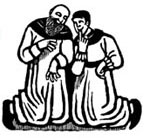
The Great Realignment of 2004-2012: The Catholic Church Splits, The Episcopal Church Triumphs
LOOKING BACKWARD FROM YEAR 2015
November 1, 2015
All Saints’ Day (Roman Catholic calendar)
All Peoples’ Day/Samhain (Episcopalian calendar)
In the fall of 2000 many observers had consigned the Episcopal Church in the U.S. (ECUSA) to the dust-bin of history. ECUSA’s General Convention — the highest decision-making authority for the denomination — had officially recognized “life-long committed relationships” outside of marriage, and had voted to send teams of enforcers to the three ECUSA dioceses that still refused to ordain women. In response, dozens of Anglo-Catholic and Evangelical parishes defected, seeking oversight from conservative Anglican provinces overseas. There were threats that Anglican primates worldwide would expel ECUSA from the Anglican Communion for apostasy. At the time, the General Convention resolution calling for a doubling of ECUSA membership by 2020 seemed to be sheer fantasy.
We now know that ECUSA was on the verge of its greatest period of growth, influence, power, and wealth. Events within and outside the Anglican Communion have again made ECUSA the pre-eminent church of the American establishment and intelligentsia, as it had been in the nation’s early history. With its partner, the newly-formed American Catholic Church (discussed later), ECUSA is now the spiritual spokesman for Americans who reject fundamentalism, pursue spiritual growth, and uphold “Unity in Diversity.”
Two Perils Averted
Before ECUSA could move to the center of the national stage, it had to overcome two threats to its survival.
The first peril was the threat of discipline from overseas conservative primates. This never occurred.
You May Also Enjoy
The practical effect of the Pope's Anglicanorum Coetibus has been to crystallize the significant differences between modern Anglicanism and Holy Mother Church.
Any full-time Church of England clergyman who worked for at least five years prior to 1992 was entitled to compensation if he resigned over women's ordination.
This is a tale of a well-organized and lofty effort by theologians, parish clergy, and laymen to recover the essence of Anglicanism in Canada.

